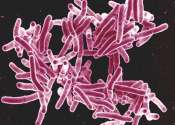Mysterious outbreak of bone-eating TB resembles an ancestral form
Tuberculosis is usually encountered as a disease of the lungs, but in 2% of cases in the U.S. it can also be found in the bones. The 9,000-year-old skeletons of some Egyptian mummies show signs of having tuberculosis infection ...
Nov 9, 2022
0
141








